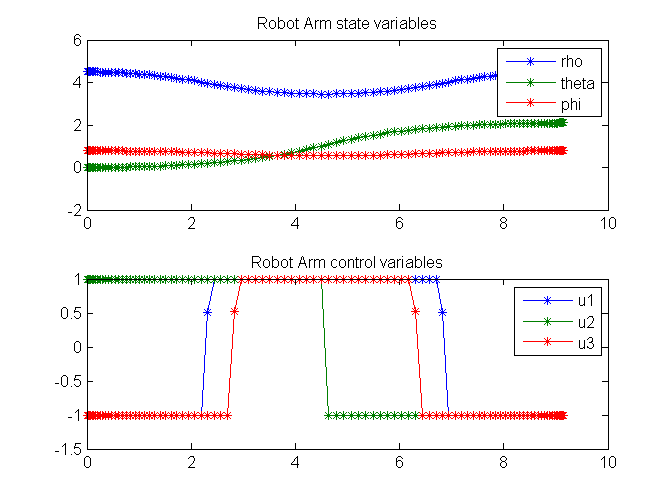PROPT Robot Arm Movement: Difference between revisions
From TomWiki
Jump to navigationJump to search
No edit summary |
No edit summary |
||
| Line 129: | Line 129: | ||
<pre> | <pre> | ||
Problem type appears to be: lpcon | Problem type appears to be: lpcon | ||
Time for symbolic processing: 0. | Time for symbolic processing: 0.3121 seconds | ||
Starting numeric solver | Starting numeric solver | ||
===== * * * =================================================================== * * * | ===== * * * =================================================================== * * * | ||
| Line 144: | Line 144: | ||
FuncEv 1 ConstrEv 17 ConJacEv 17 Iter 11 MinorIter 225 | FuncEv 1 ConstrEv 17 ConJacEv 17 Iter 11 MinorIter 225 | ||
CPU time: 0. | CPU time: 0.031200 sec. Elapsed time: 0.037000 sec. | ||
</pre> | </pre> | ||
| Line 150: | Line 150: | ||
<pre> | <pre> | ||
Problem type appears to be: lpcon | Problem type appears to be: lpcon | ||
Time for symbolic processing: 0. | Time for symbolic processing: 0.3096 seconds | ||
Starting numeric solver | Starting numeric solver | ||
===== * * * =================================================================== * * * | ===== * * * =================================================================== * * * | ||
| Line 165: | Line 165: | ||
FuncEv 1 ConstrEv 7 ConJacEv 7 Iter 4 MinorIter 729 | FuncEv 1 ConstrEv 7 ConJacEv 7 Iter 4 MinorIter 729 | ||
CPU time: | CPU time: 1.606810 sec. Elapsed time: 0.634000 sec. | ||
</pre> | </pre> | ||
Revision as of 09:07, 8 November 2011
|
This page is part of the PROPT Manual. See PROPT Manual. |
Benchmarking Optimization Software with COPS Elizabeth D. Dolan and Jorge J. More ARGONNE NATIONAL LABORATORY
Problem Formulation
Find u(t) over t in [0; 1 ] to minimize
subject to:
The boundary conditions are:
All first order derivatives are 0 at boundaries.
% Copyright (c) 2007-2008 by Tomlab Optimization Inc.Problem setup
toms t
toms t_f
% Initial guess
tfopt = 1;
x1opt = 4.5;
x2opt = 0;
x3opt = 2*pi/3*t.^2;
x4opt = 0;
x5opt = pi/4;
x6opt = 0;
u1opt = 0;
u2opt = 0;
u3opt = 0;
for n=[20 100]
%rho d(rho)dt theta d(theta)dt phi d(phi)dt
p = tomPhase('p', t, 0, t_f, n);
setPhase(p);
tomStates x1 x2 x3 x4 x5 x6
tomControls u1 u2 u3
% Initial guess
x0 = {t_f == tfopt
icollocate({x1 == x1opt
x2 == x2opt; x3 == x3opt
x4 == x4opt; x5 == x5opt
x6 == x6opt})
collocate({u1 == u1opt
u2 == u2opt; u3 == u3opt})};
% Box constraints
L = 5;
cbox = {
0.1 <= t_f <= 10
0 <= icollocate(x1) <= L
-pi <= icollocate(x3) <= pi
0 <= icollocate(x5) <= pi
-1 <= collocate(u1) <= 1
-1 <= collocate(u2) <= 1
-1 <= collocate(u3) <= 1};
% Boundary constraints
cbnd = {initial({x1 == 4.5; x2 == 0
x3 == 0; x4 == 0
x5 == pi/4; x6 == 0})
final({x1 == 4.5; x2 == 0
x3 == 2*pi/3
x4 == 0
x5 == pi/4
x6 == 0
})};
I1 = ((L-x1).^3+x1.^3)./3.*sin(x5).^2;
I2 = ((L-x1).^3+x1.^3)/3;
% ODEs and path constraints
ceq = collocate({dot(x1) == x2
dot(x2) == u1/L; dot(x3) == x4
dot(x4) == u2./I1; dot(x5) == x6
dot(x6) == u3./I2});
% Objective
objective = t_f;Solve the problem
options = struct;
options.name = 'Robot Arm';
solution = ezsolve(objective, {cbox, cbnd, ceq}, x0, options);
% Optimal x, y, and speed, to use as starting guess in the next iteration
x1opt = subs(x1, solution);
x2opt = subs(x2, solution);
x3opt = subs(x3, solution);
x4opt = subs(x4, solution);
x5opt = subs(x5, solution);
u1opt = subs(u1, solution);
u2opt = subs(u2, solution);
u3opt = subs(u3, solution);
tfopt = subs(final(t), solution);Problem type appears to be: lpcon
Time for symbolic processing: 0.3121 seconds
Starting numeric solver
===== * * * =================================================================== * * *
TOMLAB - TOMLAB Development license 999007. Valid to 2011-12-31
=====================================================================================
Problem: --- 1: Robot Arm f_k 9.146367546080650600
sum(|constr|) 0.000000278037569148
f(x_k) + sum(|constr|) 9.146367824118220500
f(x_0) 1.000000000000000000
Solver: snopt. EXIT=0. INFORM=1.
SNOPT 7.2-5 NLP code
Optimality conditions satisfied
FuncEv 1 ConstrEv 17 ConJacEv 17 Iter 11 MinorIter 225
CPU time: 0.031200 sec. Elapsed time: 0.037000 sec.
Problem type appears to be: lpcon
Time for symbolic processing: 0.3096 seconds
Starting numeric solver
===== * * * =================================================================== * * *
TOMLAB - TOMLAB Development license 999007. Valid to 2011-12-31
=====================================================================================
Problem: --- 1: Robot Arm f_k 9.140854009735493300
sum(|constr|) 0.000002639179211847
f(x_k) + sum(|constr|) 9.140856648914704500
f(x_0) 9.146367546080650600
Solver: snopt. EXIT=0. INFORM=1.
SNOPT 7.2-5 NLP code
Optimality conditions satisfied
FuncEv 1 ConstrEv 7 ConJacEv 7 Iter 4 MinorIter 729
CPU time: 1.606810 sec. Elapsed time: 0.634000 sec.
end
t = subs(collocate(t),solution);
x1 = subs(collocate(x1),solution);
x3 = subs(collocate(x3),solution);
x5 = subs(collocate(x5),solution);
u1 = subs(collocate(u1),solution);
u2 = subs(collocate(u2),solution);
u3 = subs(collocate(u3),solution);Plot result
subplot(2,1,1)
plot(t,x1,'*-',t,x3,'*-',t,x5,'*-');
legend('rho','theta','phi');
title('Robot Arm state variables');
subplot(2,1,2)
plot(t,u1,'*-',t,u2,'*-',t,u3,'*-');
legend('u1','u2','u3');
title('Robot Arm control variables');









![{\displaystyle [rho_{0}\ theta_{0}\ phi_{0}]=[4.5\ 0\ {\frac {pi}{4}}]}](https://wikimedia.org/api/rest_v1/media/math/render/svg/b5bc3baa380fc187db46ac24c767f23a46809655)
![{\displaystyle [rho_{1}\ theta_{1}\ phi_{1}]=[4.5\ {\frac {2*pi}{3}}\ {\frac {pi}{4}}]}](https://wikimedia.org/api/rest_v1/media/math/render/svg/009b2c5c8de0f5d5ee127cd148299d0166009430)

